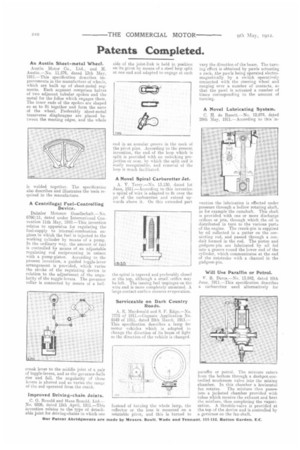Patents Completed.
Page 24

If you've noticed an error in this article please click here to report it so we can fix it.
An Austin Sheet-metal Wheel.
Austin Motor Co., Ltd., and H. Austin.—No. 11,576, dated 13th May, 1911.—This specification describes improvements in the manufacture of wheels, which are built up of sheet-metal segments. Each segment comprises halves of two adjacent tubular spokes and the metal for the kilos which engages them. The inner ends of the spokes are shaped so as to fit together and form the nave of the wheel. Preferably sheet-metal transverse diaphragms are placed between the meeting edges, and the whole is welded together. The specification also describes and illustrates the tools required in the manufacture.
A Centrifugal Fuel-Controlling Device.
Daimler Motoren Gesellschaft.—No. 6760/11, dated under International Convention 11th May, 1910.—This invention relates to apparatus for regulating the fuel-supply to internal-combustion engines in which the fuel is injected to the working cylinder by means of a pump. In the ordinary way, the amount of fuel is controlled by means of an adjustable regulating rod reciprocating in unison with a pump-piston. According to the present invention, a guided toggle-lever arrangement is provided, which varies the stroke of the regulating device in relation to the adjustment of the angularity of the toggle-levers. The governor collar is connected by means of a bell crank lever to the middle joint of a pair of toggle-levers, and as the governor-halls rise and fall, the angularity of these levers is altered arid so varies the ranss of the rod operated from the crank.
Improved Driving-chain Joinis.
C. G. Renold and Hans Renold, Ltd,— No. 9326, dated 15th April, 1911.—This invention relates to the type of detachable joint for driving-chains in which one side of the joint-link is held in position on its pivot by means of a steel loop split at one end and adapted to engage at each end in an annular groove in the neck ut the pivot pins. According to the present invention, the end of the loop which is split is provided with an unlocking pro• jection or nose, by which the split end is easily recognizable, and removal of the loop is much facilitated.
A Novel Spiral Carburetter Jet.
A. V. Terry—No. 13,130, dated let June, 1911.—According to this invention a spiral of wire is adapted to fit over the jet of the carburetter and extend upwards above it. On this extended part the spiral is tapered and preferably closed at the top, although a small orifice may be left. The issuing fuel impinges on the wire and is more completely atomized. A large contact surface ensures evaporation.
Serviceable on Dark Country Roads.
A. E. Macdonald and S. F. Edge.—No. 7775 of 1911.—Cognate Application No. 9149 of 1911, dated 28th March, 1911,— This specification describes a lamp for motor vehicles which is adapted to change the direction of its beam of light as the direction of the vehicle is changed.
Instead of turaing the whole lamp, the reflector or the lens is mounted on a rotatable pivot, and this is turned to vary the direction of the beam. The turning effect is obtained by pawls actuating a rack, the pawls being operated electromagnetically by a switch operatively connected with the steering wheel and ranging over a number of contacts, so that the pawl is actuated a number of times corresponding to the amount of t tuning.
A Novel Lubricating System.
C. H. de Rusett.—No. 12,874, dated 29th May, 1911.—According to this in
vention the lubrication is effected under pressure through a hollow rotating shaft, as for example the camshaft. This shaft is provided with one or more discharge orifices or jets, through which the oil is distributed in turn to the various parts of the engine. The crank-pin is supplied by oil collected in a gutter on the connecting rod, and passed through a conduit formed in the rod. The piston and gudgeon-pin are lubricated by oil fed into a groove round the lower end of the cylinder, which communicates at the end of the outstroke with a channel in the gudgeon-pin.
Will Use Paraffin or Petrol.
r, R. Davis.—No. 13.842, dated 10th June. 1911.—This specification describes a carburetter used alternatively for
paraffin or petrol. The mixture enters from the bottom through a dashpot-controlled mushroom valve into the mixing chamber. In this chamber a horizontal fan rotates. The mixture then passe into a jacketed chamber provided with tubes which receive the exhaust and heat the mixture, thus completing the vaporization. A throttle-valve is provided at the top of the device and is controlled by a governor on the fan-shaft.
























